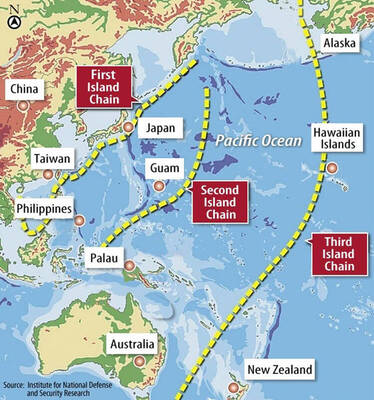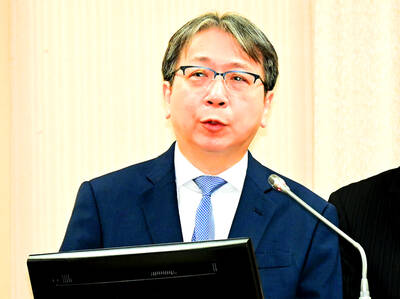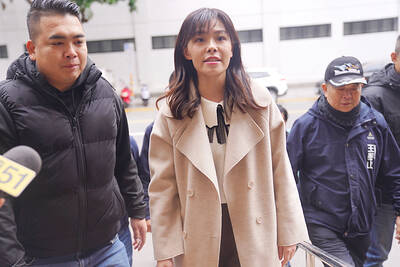Calm was restored to the southern Chinese city of Shenzhen yesterday after hundreds of rioters attacked police to protest the death of a motorcyclist, police and witnesses said.
Anger flared when Li Guochao (李國超), 31, crashed into a lamppost after a local official threw a walkie-talkie at him as he sped away from a checkpoint, the city’s public security bureau said in a statement.
Protests, led by Li’s angry family, broke into anti-police violence on Friday afternoon and lasted until the early hours yesterday, with rioters burning a police car, the statement said.
The protest was the latest in a series of confrontations over social issues in China, where tens of thousands of riots erupt each year, many stemming from grievances over abuse of power, corruption or land grabs.
The street where the violence took place had returned to normal yesterday afternoon, with vendors working and shops open, a reporter at the scene said.
There was a beefed up police presence outside the station near where the riots took place.
“There were thousands of people trying to get close to the police station,” said one shop owner, who witnessed the riots.
“They tried to turn over the police car and people were smashing the windows with knives,” said the woman, who did not want to be named.
The police statement said the official who threw the walkie-talkie was not a police officer, and that the only police presence was a traffic officer 300m away from the checkpoint.
“However, the relatives of Li Guochao thought that the checkpoint was organized by the police,” the statement said.
Li had been stopped at the checkpoint in the city’s Bao’an district, the statement said. He was carrying a passenger, who got off before Li sped away. An official tried to block his path, but was ignored and then threw the walkie-talkie at Li, who lost control of his motorcycle and then crashed into the lamppost, the statement said.
He was taken to hospital where he died a few hours later, the statement said.
Li’s relatives called together a group of around 30 people and at around 2:30pm, they carried Li’s body to the police station, “smashed things” and started setting off firecrackers, the statement said.
By 5pm, more than 400 people had gathered at the police detachment with more than 2,000 others watching nearby. Some people threw stones and set fire to a police car, the statement said.
Police were only able to disperse the crowd at 2am. There were no other reports of injuries.
The official who threw the walkie-talkie has been detained by police, the statement said.
Shenzhen is a thriving city of more than 8 million people, lying just across the border from Hong Kong.
It has been transformed from a fishing village over the past 30 years after it was chosen by former leader Deng Xiaoping (鄧小平) to be at the vanguard of economic reforms.
People living in the area said the checkpoints had been set up to enforce a ban on motorcycles, set up after a spate of muggings by riders who snatched handbags.
One taxi driver in Shenzhen said it was widely believed that some of the police in the area were corrupt.
“The police say they are working for the people, but what actually happens is they just work for money,” said the driver, who only gave his surname as Ma.
In June, tens of thousands of people rioted in southwest Guizhou Province over claims police had covered up the alleged rape and murder of a teenage girl.
And last month a Shanghai court rejected an appeal from an unemployed man who became an unlikely cult hero after murdering six policemen in what he said was revenge for a wrongful arrest.
His case became a lightning rod for controversy by raising questions about police harassment, with some regarding him as a victim who stood up to abuse commonly suffered by marginalized people in Chinese society.

The US government has signed defense cooperation agreements with Japan and the Philippines to boost the deterrence capabilities of countries in the first island chain, a report by the National Security Bureau (NSB) showed. The main countries on the first island chain include the two nations and Taiwan. The bureau is to present the report at a meeting of the legislature’s Foreign Affairs and National Defense Committee tomorrow. The US military has deployed Typhon missile systems to Japan’s Yamaguchi Prefecture and Zambales province in the Philippines during their joint military exercises. It has also installed NMESIS anti-ship systems in Japan’s Okinawa

‘WIN-WIN’: The Philippines, and central and eastern European countries are important potential drone cooperation partners, Minister of Foreign Affairs Lin Chia-lung said Minister of Foreign Affairs Lin Chia-lung (林佳龍) in an interview published yesterday confirmed that there are joint ventures between Taiwan and Poland in the drone industry. Lin made the remark in an exclusive interview with the Chinese-language Liberty Times (the Taipei Times’ sister paper). The government-backed Taiwan Excellence Drone International Business Opportunities Alliance and the Polish Chamber of Unmanned Systems on Wednesday last week signed a memorandum of understanding in Poland to develop a “non-China” supply chain for drones and work together on key technologies. Asked if Taiwan prioritized Poland among central and eastern European countries in drone collaboration, Lin

ON ALERT: Taiwan’s partners would issue warnings if China attempted to use Interpol to target Taiwanese, and the global body has mechanisms to prevent it, an official said China has stationed two to four people specializing in Taiwan affairs at its embassies in several democratic countries to monitor and harass Taiwanese, actions that the host nations would not tolerate, National Security Bureau (NSB) Director-General Tsai Ming-yen (蔡明彥) said yesterday. Tsai made the comments at a meeting of the legislature’s Foreign Affairs and National Defense Committee, which asked him and Minister of National Defense Wellington Koo (顧立雄) to report on potential conflicts in the Taiwan Strait and military preparedness. Democratic Progressive Party (DPP) Legislator Michelle Lin (林楚茵) expressed concern that Beijing has posted personnel from China’s Taiwan Affairs Office to its

BACK TO WORK? Prosecutors said they are considering filing an appeal, while the Hsinchu City Government said it has applied for Ann Kao’s reinstatement as mayor The High Court yesterday found suspended Hsinchu mayor Ann Kao (高虹安) not guilty of embezzling assistant fees, reducing her sentence to six months in prison commutable to a fine from seven years and four months. The verdict acquitted Kao of the corruption charge, but found her guilty of causing a public official to commit document forgery. The High Prosecutors’ Office said it is reviewing the ruling and considering whether to file an appeal. The Taipei District Court in July last year sentenced Kao to seven years and four months in prison, along with a four-year deprivation of civil rights, for contravening the Anti-Corruption